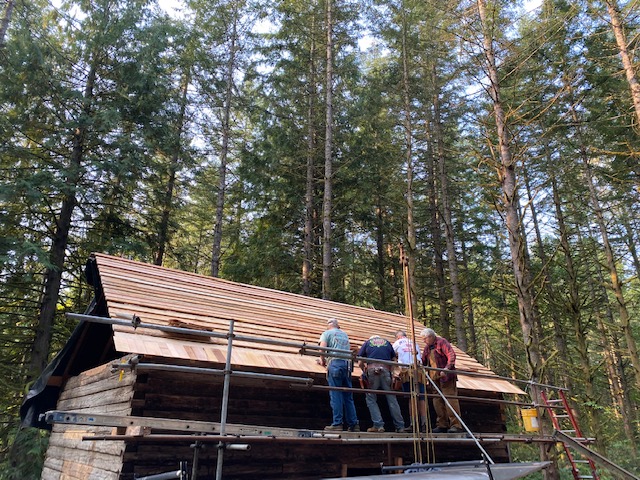Photo taken Hopkins Demonstration Forest Summer 2020
History writer, Fred Leeson (buildingonhistory.blogspot.com) wrote this about the Molalla Log House in September 2020.
Hopkins is the perfect location for this rare historic log building, where it will be a part of the overall educational programming for students and visitors. Here it will be interpreted for its wood craftsmanship and historic association. All rehabilitation work has been done carefully by experts in woodcraft to ensure that the logs and design of the building retain its historic integrity and that it is preserved to the greatest possible extent. The building will be sited near the newly constructed ponds at Hopkins and will present a fitting historic landscape for this unique and highly crafted log building.
The Molalla Log House may be the oldest building in Oregon, if not the entire Pacific Northwest. It was made of Douglas fir, without the use of nails, and was possibly felled in the forest and hewn by axe by fur hunters and trappers who migrated from Canada over the Rocky Mountains in the late 1790s. The craftsmanship indicates that the original creators were expert builders who had learned their craft from centuries old techniques. The logs were hewn square and stacked horizontally to create a tight fitting 1 ½ story, 18’ by 25’ log building.
Prior to dismantling the log building for preservation and rehabilitation in 2008, the beautiful half dovetail notching held the corners of the building together securely for over 200 years in the Molalla region of the foothills of the Cascades. Even after 12 years of careful study of the building and its possible history, the origins of the Molalla Log House remain a mystery. The original builders did not write in journals or document the building or their early stay in the wilderness of the Oregon Territory. What they did leave is evidence of their brief occupation – an example of expert woodcraft and a fortified log building that stood on the landscape for two centuries – which was probably later used by French Canadian Freemen fur hunters, early American pioneer farmers and later 20th century owners.

Fortunately, recent major forest fires in Clackamas County did not threaten the Molalla Log House, the venerable building that may be among the oldest in Oregon, undergoing restoration in the Hopkins Experimental Forest north of Mulino. The history of this interesting structure was related in an Aug. 12 article on this blog. Hand-hewn timbers that were rescued years ago from another location are believed to be from 140 to more than 200 years old, depending on which analysis one chooses to accept. While all the timbers fit together tightly without need for metal fasteners, modern building codes would not allow reconstruction of the roof without steel support.
Pamela Hayden, who has dedicated many years to saving and reconstructing the log building, said there was no choice other than adding steel supports so the building eventually can be used for tours and meetings. “We will have a seismically safe building,” Hayden says. “The irony is that in the recent fires the only thing that remains in severely burned wooden buildings are their steel components – sadly stark in the embers.”
Research suggests that the building has had several roofs during its lengthy life. The exact nature of the original one is not known. Gregg Olson, a craftsman and scholar of historic woodworking, is fabricating a roof that he believes to be close to what the original may have been. “Preservationists must stay steadfast,” Hayden says. “Our first priority was to do everything possible to keep the original integrity of the log building as close to the original builders’ intent as possible – trying to adhere closely to the Secretary of Interior Standards for Historic Rehabilitation. This took a lot of study, research, time and last but not least – new Douglas fir wood and lots of money to hire the labor of qualified and knowledgeable craftsmen. “We definitely had to be open to making some modifications since another priority was to make the building accessible to the pubic inside and out. The good news is we will have a building that will last at least another 100 years (hopefully) with ongoing maintenance – that can be enjoyed by generations of new learners and architectural history buffs.”
Article taken from buildingonhistory.blogspot.com

